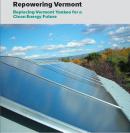We are on the edge of making the biggest decision about Vermont’s energy future in the past 40 years. The choice to repower Vermont with renewable energy resources or commit to an additional 20 years of Vermont Yankee will determine the legacy we leave future Vermonters.
Closing Vermont Yankee and moving forward with energy efficiency and local renewable energy would cost Vermonters 47–50% less, between 2012 and 2032, than relying on Vermont Yankee at predicted market prices. Replacing Vermont Yankee with local renewable energy resources would also add tens of millions of dollars to our state tax base and support the creation of hundreds if not thousands of new jobs.
The way that electricity is being produced, distributed and even used is undergoing monumental change. Wind power and solar power, which were once fringe energy sources, are now being talked about as main stays of our energy future.Massive coal and nuclear plants are increasingly seen as symbols of the past and not compatible with a smart energy grid. Clean technology is moving fast to develop large scale energy storage and advanced batteries for plug-in hybrid and electric vehicles, and our traditionally slow-to-change utility industry is running to keep pace.
The old ways of generating electricity— oil, coal, and nuclear—have created unsustainable environmental and economic costs. Continued reliance on these old technologies will only worsen the situation we face in years to come and we cannot simply pass these costs on to the next generation.
Globally, our climate is in jeopardy from increased greenhouse gas pollution and collectively, Vermonters emit approximately 8,000,000 metric tons of global warming pollution every year.
The Vermont Yankee nuclear reactor has generated more than 1 million pounds of radioactive waste which is stored on the banks of the Connecticut River and will remain radioactive for more than 100,000 years. It is estimated to cost millions of dollars every year to protect the waste and it will cost an estimated $1 billion dollars to decontaminate and decommission the reactor site.
All of the nuclear and fossil fuels used in Vermont are imported to the state. In an age of increasing supply constraints and market volatility, this is an untenable economic, political and social situation.
Repowering Vermont lays out two clear and achievable visions for replacing Vermont Yankee with local renewable resources. The first,moderate, scenario was designed to meet our traditional electricity demand and anticipates a slow transition to more electricity being used in our transportation sector. The second, strong renewable energy growth, scenario sought to identify how much renewable energy could be built in Vermont over the next two decades. The results exceeded all of our expectations. Vermont could meet well over 100% of its future electricity demand, including complete electrification of our transportation sector, with in-state generation and existing levels of regional hydroelectric power.

